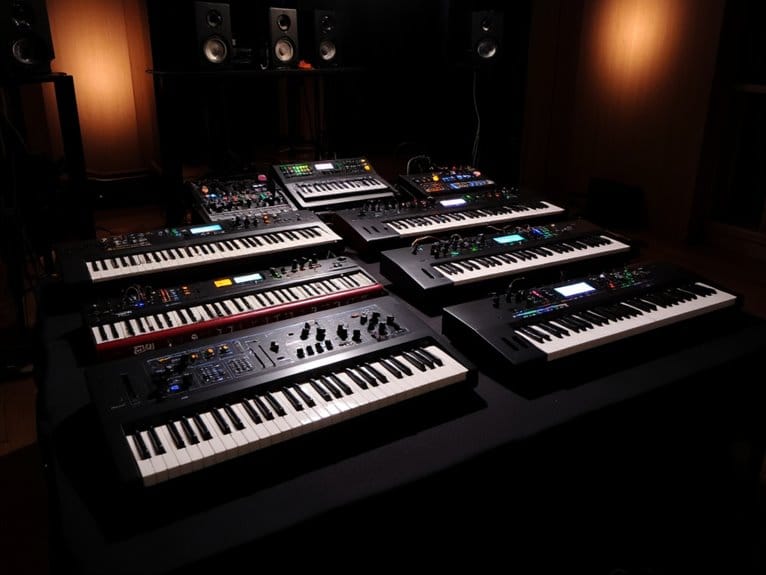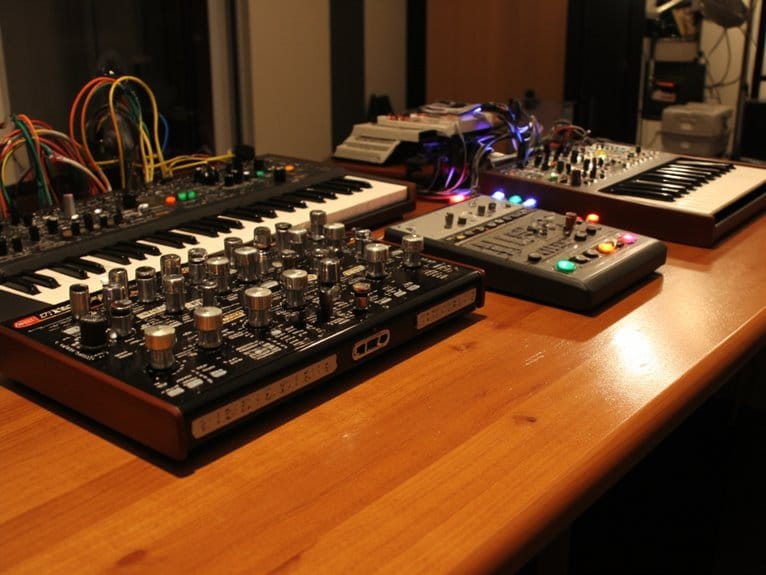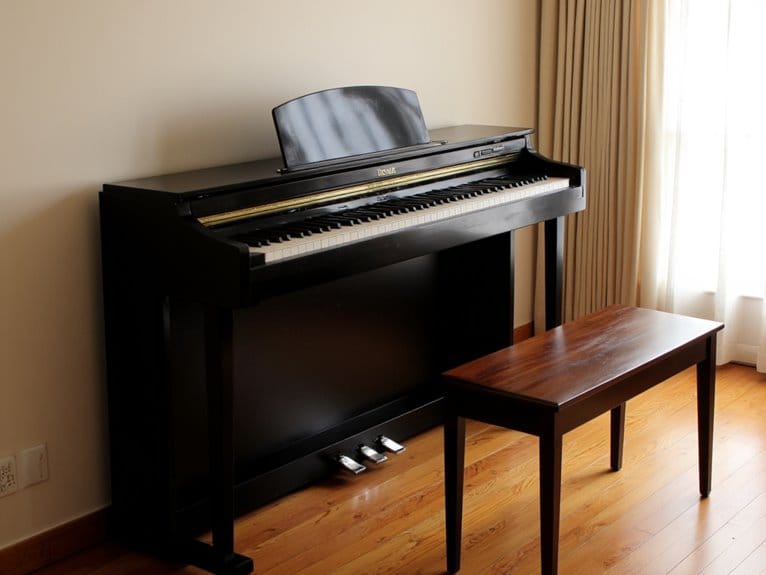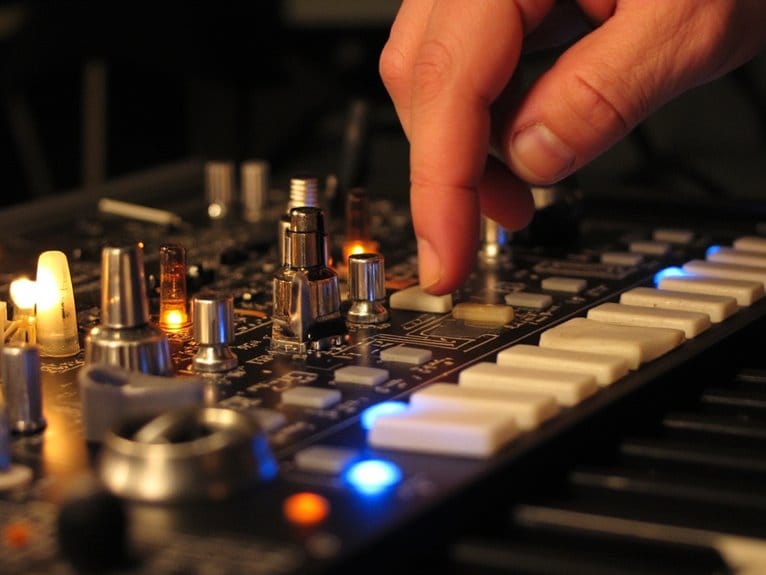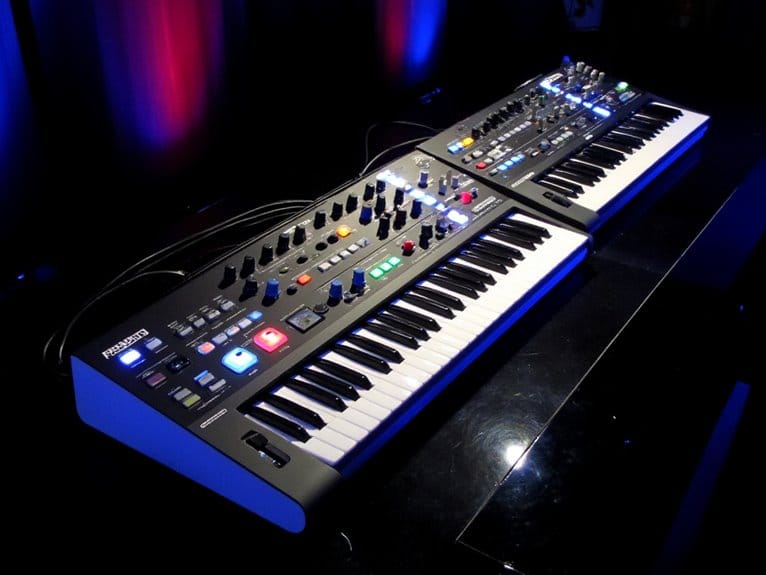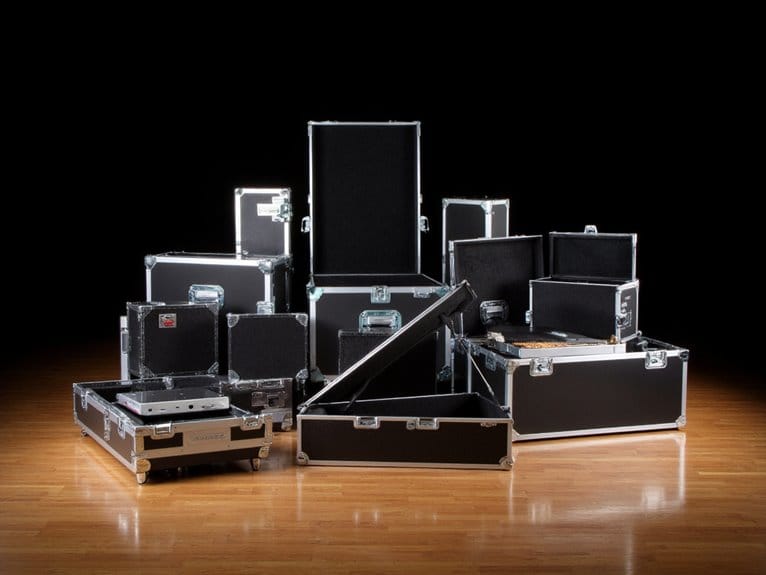Best Akai Keyboards for Music Production
I’ve found Akai’s 2025 keyboard lineup offers exceptional variety, from the ultra-portable 2-pound MPK Mini MK3 with its 8 backlit drum pads to the all-encompassing MPC Key 37 featuring standalone production capabilities and 37 velocity-sensitive keys. The MPK Mini Plus stands out with its 64-step sequencer for computer-independent composition, while the LPK25 weighs under a pound for maximum portability. Each model balances specific workflow needs with solid build quality, and exploring their unique features reveals which controller matches your production style.
We are supported by our audience. When you purchase through links on our site, we may earn an affiliate commission, at no extra cost for you. Learn more.
Notable Insights
- The Akai MPK Mini MK3 offers exceptional portability at 2 pounds with 8 backlit drum pads and built-in arpeggiator functionality.
- Akai MPK Mini Plus features 37 mini keys with a 64-step sequencer for standalone composition without computer dependency.
- The MPK Mini Play MK3 provides battery-powered operation with built-in speaker and over 100 internal sounds for mobile production.
- AKAI LPK25 weighs under 1 pound with laptop bag compatibility, featuring programmable presets for seamless DAW integration.
- Akai MPC Key 37 delivers desktop-level functionality combining synthesizer, sampler, and sequencer with extensive plugin support through MPC2 software.
Akai Professional MPK Mini MK3 – 25 Key USB MIDI Keyboard Controller
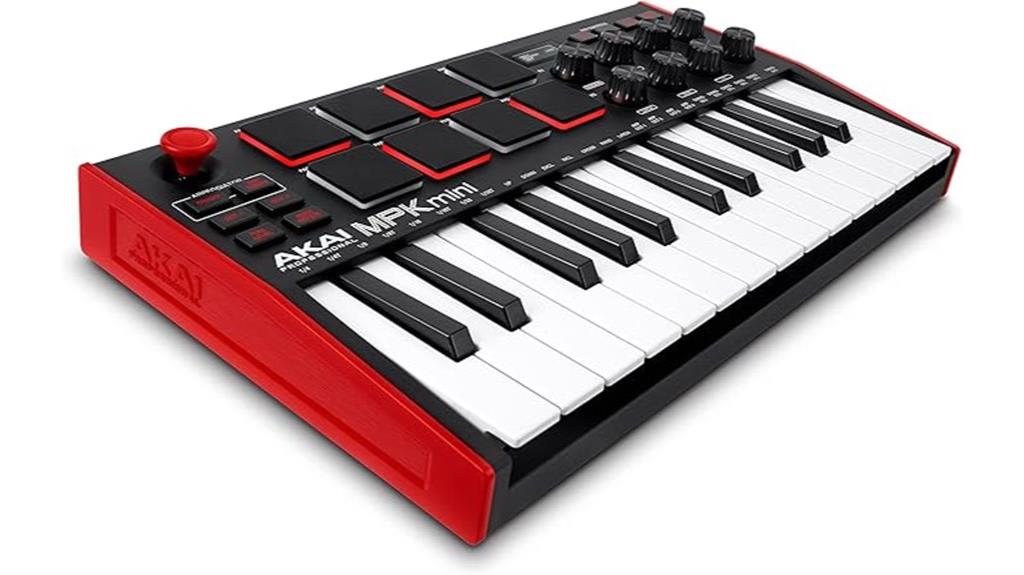
If you’re searching for a compact MIDI controller that doesn’t sacrifice functionality for portability, the Akai Professional MPK Mini MK3 stands out as an exceptional choice for both traveling producers and bedroom studio enthusiasts. This 25-key controller packs eight backlit MPC-style drum pads, eight assignable knobs, and a 4-way thumbstick into just 2 pounds, making it remarkably travel-friendly without compromising creative potential. You’ll appreciate the velocity-sensitive keys and pads that respond dynamically to your playing style, while the built-in arpeggiator and Note Repeat functions add professional-grade sequencing capabilities that rival larger, more expensive units.
Best For: Beginners and experienced producers seeking an affordable, portable MIDI controller for travel or compact home studios who want professional features like velocity-sensitive pads, built-in arpeggiator, and seamless DAW integration.
Pros:
- Exceptional portability at just 2 pounds with comprehensive features including 8 backlit drum pads, 8 assignable knobs, and 4-way thumbstick for pitch/modulation control
- Plug-and-play functionality with universal DAW compatibility and included MPC Beats software plus 3 virtual instruments and 2GB of sound content
- Outstanding value with velocity-sensitive keys and pads, built-in arpeggiator, and Note Repeat functions typically found on more expensive controllers
Cons:
- Plastic construction may feel less premium compared to higher-end controllers with metal components
- Included MPC Beats software has a steep learning curve and the free version is limited to 8 MIDI tracks and 2 audio tracks
- Compact 25-key layout may feel restrictive for musicians accustomed to full-sized keyboards or those requiring extended note ranges
AKAI Professional LPK25 USB MIDI Keyboard Controller (25 Keys)
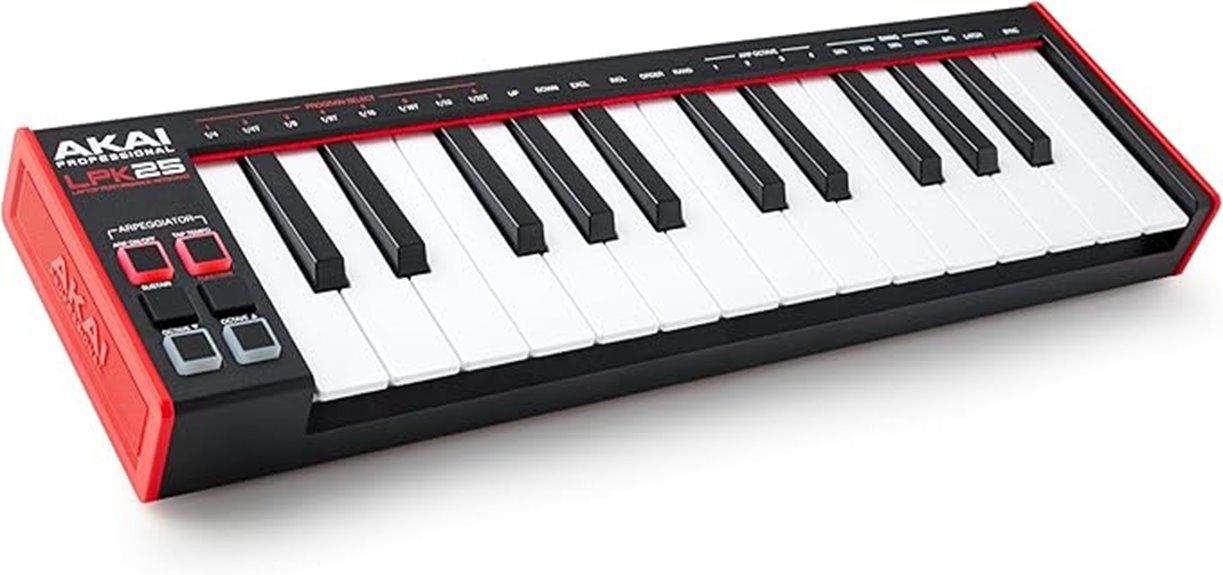
Musicians who need a truly portable MIDI controller that won’t sacrifice functionality will find the AKAI Professional LPK25 hits that sweet spot between compact design and professional capabilities. Measuring just 13.7 inches wide and weighing under a pound, this controller slides into your laptop bag without demanding its own compartment, though I’ll admit the smaller keys require some adjustment if you’re accustomed to full-sized keyboards. The Gen 2 Dynamic keybed delivers impressive velocity response for such a compact unit, while eight programmable presets let you quickly switch between your favorite DAW mappings. The built-in arpeggiator and sustain button add creative possibilities that many ultra-portable controllers skip entirely.
Best For: Musicians, producers, and DJs who need a highly portable MIDI controller for travel, mobile production, or tight studio spaces without sacrificing essential features like velocity sensitivity and programmable presets.
Pros:
- Exceptional portability at under 1 pound with compact 13.7-inch width that easily fits in laptop bags
- Gen 2 Dynamic keybed provides impressive velocity response and natural feel for such a small controller
- Includes professional features like built-in arpeggiator, 8 programmable presets, and seamless plug-and-play compatibility with major DAWs
Cons:
- Smaller key size requires adjustment period for users accustomed to full-sized keyboards, particularly those with larger hands
- USB connector stability issues reported by some users
- Limited to 25 keys which may restrict playing range for more complex musical passages
Akai Professional MPC Key 37 Standalone Production Synthesizer
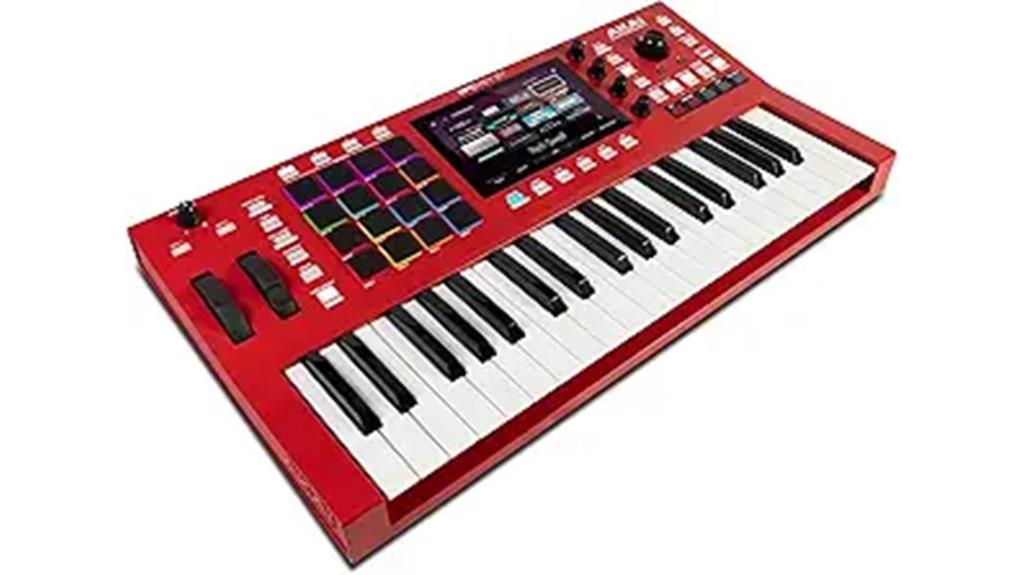
Standalone production powerhouses like the Akai Professional MPC Key 37 represent a sweet spot for producers who crave desktop-level functionality without the computer dependency, and I’ve found this particular unit excels at bridging the gap between traditional hardware and modern workflow demands. You’re getting 37 velocity-sensitive keys with aftertouch, 16 RGB pads, and connectivity options that’ll satisfy most studio configurations, including CV/Gate outputs for modular enthusiasts. The 128-track capability, combined with nearly unlimited plugin support through MPC2 software, means you won’t outgrow this machine quickly, though the 22GB user storage might feel constraining for sample-heavy workflows.
Best For: Producers and musicians who want a powerful, computer-free production workstation that combines synthesizer, sampler, and sequencer capabilities with modern connectivity and plugin support.
Pros:
- Standalone operation with 128-track capability and extensive plugin support eliminates computer dependency while maintaining professional-grade functionality
- Comprehensive connectivity including CV/Gate outputs, MIDI I/O, and multiple audio inputs makes it compatible with both modern and modular setups
- High-quality 37-key synth-action keybed with aftertouch and 16 velocity-sensitive RGB pads provide excellent tactile control for performance and production
Cons:
- Limited 22GB user storage may require frequent sample management or external storage solutions for sample-heavy projects
- At 8.82 pounds, it’s relatively heavy for a “portable” standalone unit compared to smaller grooveboxes
- Higher price point compared to simpler drum machines or basic synthesizers may be prohibitive for beginner producers
Akai Professional MPC Key 61 – Standalone Music Production Synthesizer Keyboard
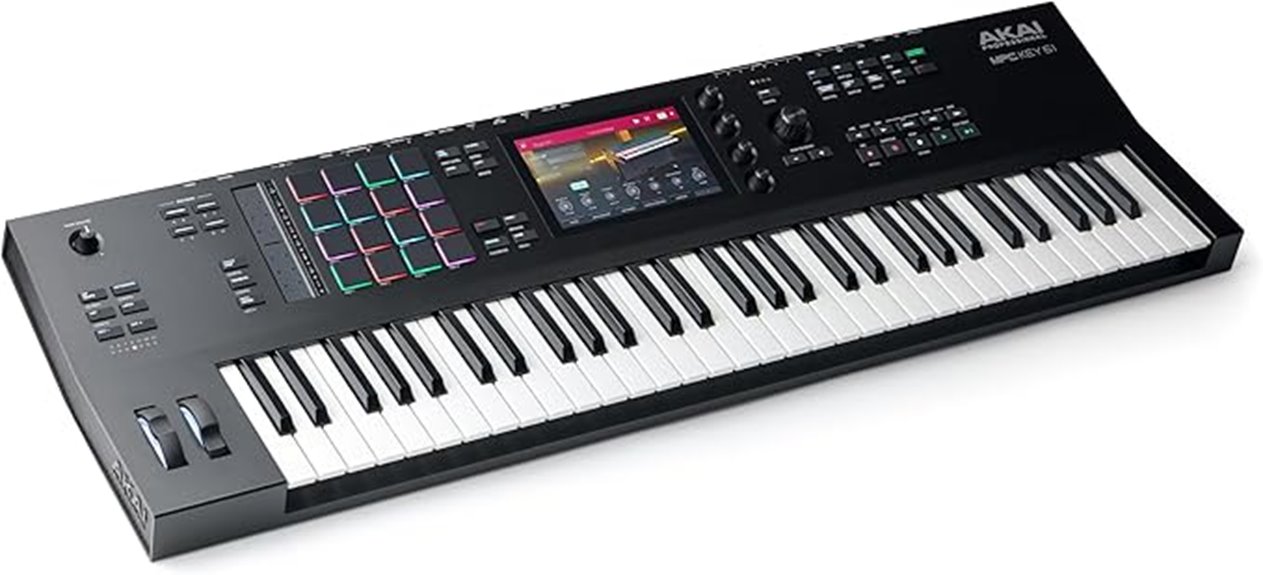
When you’re looking for a workstation that combines the tactile feel of traditional keyboards with modern production capabilities, the Akai Professional MPC Key 61 delivers a compelling solution that bridges the gap between studio and stage performance. With 61 semi-weighted keys featuring aftertouch, you’ll experience responsive control that translates musical expression into digital precision. The 25 plugin instrument engines provide access to over 6,000 customizable sounds, while 16 velocity-sensitive RGB drum pads expand your rhythmic possibilities beyond traditional keyboard layouts. I’ve found the 24-bit audio interface with high-end preamps particularly valuable for standalone vocal production, eliminating the need for additional hardware in many situations.
Best For: Musicians, producers, and composers who need a standalone workstation that combines traditional keyboard playing with modern beat-making and production capabilities for both studio and live performance settings.
Pros:
- Comprehensive standalone production system with 25 plugin engines, 6,000+ sounds, and 100+ effects eliminating the need for external software or hardware
- High-quality 24-bit audio interface with professional preamps and extensive connectivity options including MIDI, CV/Gate, and wireless capabilities
- Intuitive design combining 61 semi-weighted keys with aftertouch, velocity-sensitive RGB drum pads, and touch screen for versatile music creation
Cons:
- Higher price point compared to basic MIDI controllers or simple workstations due to its comprehensive feature set
- Learning curve may be steep for beginners unfamiliar with MPC workflow or advanced production techniques
- Physical size and weight make it less portable than compact MIDI controllers despite being designed for mobile use
AKAI Professional APC Key 25 MK2 USB MIDI Keyboard Controller
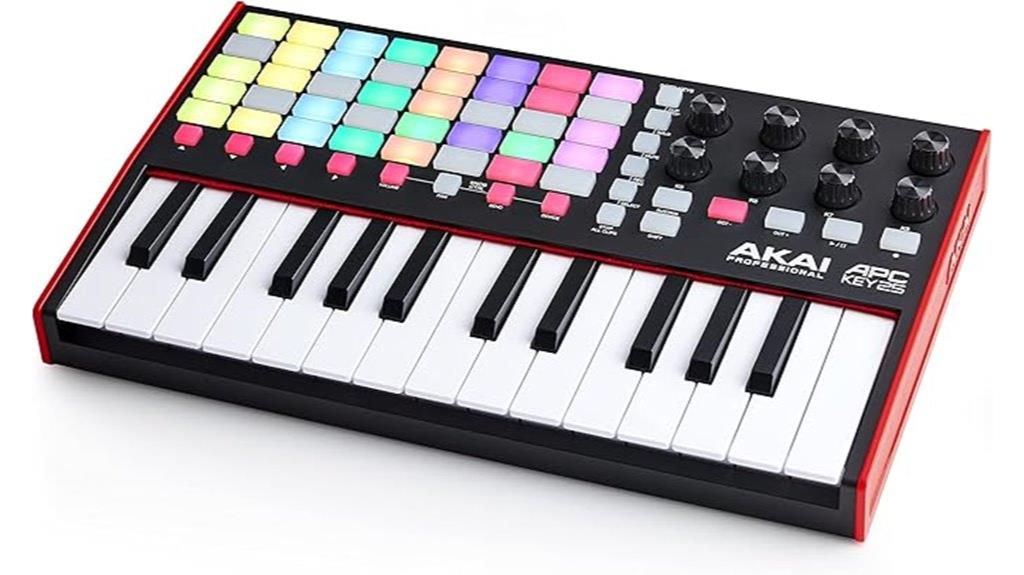
The AKAI Professional APC Key 25 MK2 stands out as the ideal choice for producers who need seamless Ableton Live integration combined with portable clip launching capabilities, featuring 40 RGB pads that provide instant visual feedback for real-time performance control. You’ll appreciate the 25 velocity-sensitive mini keys paired with eight assignable rotary knobs that handle everything from volume adjustments to complex effect automation. The compact 1.98-pound design fits easily into standard bags, while the plug-and-play USB connectivity eliminates power adapter hassles during live performances. I’ve found the transport controls particularly responsive for one-touch recording, though some users note the touch faders can affect precise parameter adjustments.
Best For: Producers and performers who need a compact, portable MIDI controller with seamless Ableton Live integration and visual feedback for clip launching and real-time music creation.
Pros:
- 40 RGB pads provide excellent visual feedback for clip launching with seamless Ableton Live integration
- Compact and lightweight design (1.98 pounds) with plug-and-play USB connectivity makes it highly portable for live performances
- Versatile control options including 25 velocity-sensitive keys, 8 assignable rotary knobs, and responsive transport controls for comprehensive music production
Cons:
- Touch faders can negatively impact precise parameter adjustments and continuous control
- Mini keys may feel cramped for users accustomed to full-size keyboard keys
- Limited to 25 keys which restricts range for complex chord progressions and melodies
AKAI Professional MPK249 USB MIDI Keyboard Controller with 49 Keys
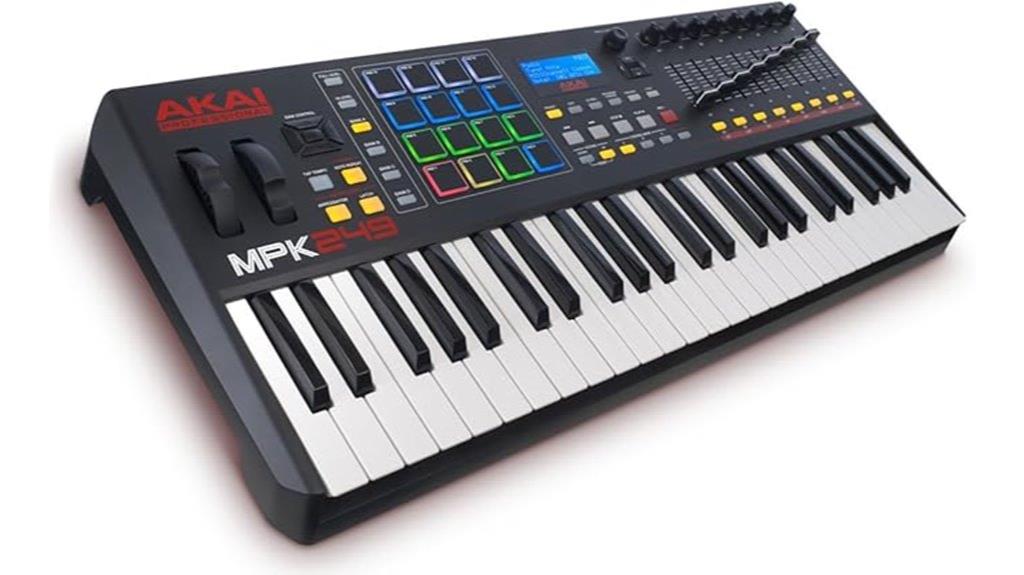
Striking the perfect balance between professional capabilities and accessible pricing, the AKAI Professional MPK249 stands out as my top recommendation for intermediate producers who’ve outgrown basic controllers but aren’t ready to invest in flagship models. You’ll appreciate the 49 semi-weighted keys with aftertouch, which provide that natural playing feel I find essential for expressive performances. The 16 RGB-illuminated MPC-style pads across four banks give you 64 total pads, while 24 assignable Q-Link controllers offer extensive hands-on control. With bundled software including Ableton Live Lite and MPC Beats, you’re getting serious value that justifies its position.
Best For: Intermediate music producers who need professional-grade features like semi-weighted keys with aftertouch and extensive control options without the high cost of flagship models.
Pros:
- 49 semi-weighted, velocity-sensitive keys with aftertouch provide natural playing feel for expressive performances
- 16 RGB-illuminated MPC-style pads with 4 banks offer 64 total pads plus 24 assignable Q-Link controllers for comprehensive hands-on control
- Excellent value with bundled software including Ableton Live Lite, MPC Beats, and additional production tools
Cons:
- Limited preset options and customization settings may require workarounds for complex setups
- Mixed customer support feedback from Akai could be problematic if issues arise
- Learning curve required to effectively utilize all features and capabilities
Factors to Consider When Choosing an Akai Keyboard
When I’m evaluating Akai keyboards for my studio setup, I focus on five critical factors that directly impact workflow efficiency, creative potential, and overall production quality. The key count determines your melodic range while action type affects playing feel, pad sensitivity influences drum programming responsiveness, and control elements like knobs and faders streamline real-time parameter adjustments during recording sessions. I’ve learned that software bundles, portability features, and power options can make or break a keyboard’s practical value, especially when you’re working across multiple locations or need specific DAW integrations.
Key Count and Action
One of the most crucial decisions you’ll face when selecting an Akai keyboard involves determining the ideal key count and action type for your specific production needs, as these factors directly impact both your creative workflow and the instrument’s practical utility. I’ve found that smaller keyboards with 25-37 keys excel in portability, making them perfect for mobile production sessions, though you’ll sacrifice range for convenience. Larger 49-61 key models provide the real estate needed for complex compositions, allowing full two-handed playing that mimics traditional piano techniques. Pay attention to velocity sensitivity and semi-weighted action, which enhance expressiveness considerably. Aftertouch capability adds another dimension to your performances, letting you shape sounds through post-strike pressure variations.
Pad Sensitivity and Features
The drum pads on Akai keyboards represent perhaps the most distinctive feature that sets these controllers apart from generic MIDI keyboards, offering tactile responsiveness that transforms how you interact with your digital audio workstation during both composition and live performance. I’ve found the velocity-sensitive pads respond exceptionally well to varying touch intensity, making sample triggering and drum programming feel natural and expressive. The RGB backlit design enhances visibility during late-night sessions while providing instant visual feedback on pad status and trigger actions. Models like the MPK Mini and MPK Play include specialized performance modes such as Note Repeat, arpeggiators, Chords, and Scales, which streamline creative workflows without requiring extensive music theory knowledge, allowing you to focus on musical ideas rather than technical limitations.
Control Knobs and Faders
Beyond the expressive drum pads, control knobs and faders serve as your direct connection to real-time parameter manipulation, transforming static software interfaces into tactile mixing consoles that respond to your every adjustment. I find that assignable controls make the difference between awkward mouse clicking and intuitive workflow, especially when you’re deep in a creative session and don’t want to break your momentum.
The number of assignable Q-Link controllers varies dramatically across Akai models, with some offering up to 24 customizable controls that you can map to virtually any software parameter. Those 360-degree rotary encoders give you precise control over everything from filter cutoffs to reverb sends, while dedicated faders handle your mix levels with the smooth response you’d expect from professional mixing boards.
Software Bundle Inclusions
When you’re evaluating Akai keyboards, I’ve learned that the software bundle often determines whether you’ll start making music immediately or spend hours hunting down additional tools and sounds. Most models include MPC Beats, which I consider essential DAW software for beginners, though the free version comes with limitations like restricted MIDI and audio track counts that you’ll eventually outgrow. The MPK Mini MK3, for instance, ships with virtual instruments and sound content that create a thorough starter kit, while many keyboards support Native Kontrol Standard for seamless integration with included software bundles. I’ve found that additional sound libraries and expansion packs included in certain bundles greatly expand your creative possibilities across diverse musical styles.
Portability and Power Options
Mobility becomes essential when you’re deciding between studio-bound production and on-the-go creativity, and I’ve discovered that Akai’s approach to portability varies dramatically across their keyboard lineup. The MPK Mini and LPK25 exemplify compact design philosophy, prioritizing lightweight construction that won’t strain your shoulder bag during those inevitable late-night sessions. I particularly appreciate USB-powered models for their plug-and-play simplicity, eliminating the clutter of power adapters that somehow always disappear when needed most. Battery-operated options like the M-VAVE 25 Key offer genuine wireless freedom with 16-hour operation, perfect for outdoor composing or coffee shop sessions. Consider your workflow demands carefully, as weight restrictions and power requirements can make or break your mobile production setup.
Connectivity and Compatibility
Universal connectivity separates professional-grade keyboards from weekend hobbyist tools, and I’ve learned this distinction often determines whether your creative workflow thrives or constantly battles technical roadblocks. I always prioritize USB-powered functionality first, since plug-and-play compatibility across Windows and Mac DAWs eliminates those frustrating setup sessions that kill creative momentum. MIDI I/O ports become essential when you’re expanding beyond basic controller duties, allowing connections to hardware synthesizers, drum machines, and modular gear that USB alone can’t handle. CV/Gate outputs open entirely new possibilities for eurorack integration, though admittedly, I didn’t appreciate their value until diving deeper into analog synthesis. Native Kontrol Standard support streamlines software instrument mapping, particularly with Native Instruments products, creating seamless parameter control that feels intuitive rather than tedious.
On a final note
I’ve tested dozens of keyboards over the years, and these Akai models consistently deliver reliable performance for music production. Whether you’re starting with the budget-friendly MPK Mini MK3 or investing in the standalone MPC Key 37, each controller offers distinct advantages depending on your workflow, studio space, and creative needs. Choose based on your key count preferences, required features, and budget constraints—you can’t really go wrong with any of these selections.

